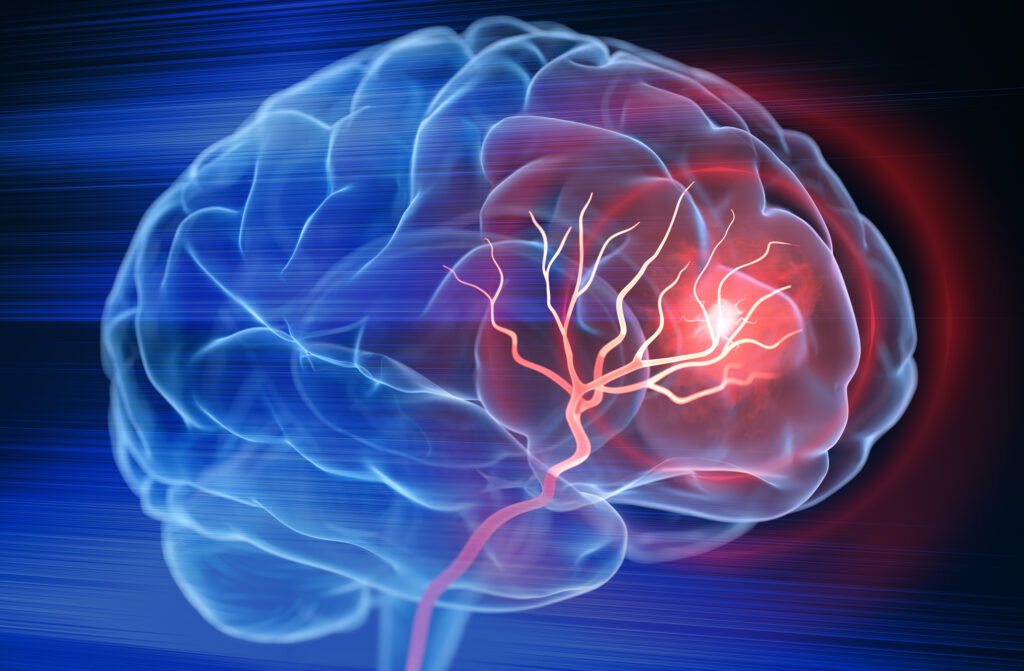Each year, thousands of stroke survivors are left with hemianopia, loss of vision on one side of the visual field, an impairment that affects reading, driving, navigation, and overall independence. While rehabilitation can help patients adapt, meaningful restoration of visual function has remained difficult, often requiring months of intensive training with only limited improvement.
New research from the Neuro‑X Institute at the École Polytechnique Fédérale de Lausanne (EPFL) now suggests that pairing visual training with a precisely targeted brain stimulation protocol may significantly accelerate recovery. In a randomized, placebo-controlled, double-blind clinical trial reported in Brain, researchers demonstrated that a specialized form of transcranial alternating current stimulation (tACS) can restore disrupted communication between key visual brain regions and improve motion perception in patients with chronic hemianopia.
The work addresses a central challenge in post-stroke vision restoration: when the primary visual cortex (V1) is damaged, surviving regions must coordinate with downstream visual areas to process visual input. This communication normally relies on finely timed electrical oscillations—low-frequency alpha rhythms from V1 that modulate high-frequency gamma activity in the motion-processing medio-temporal cortex (MT). Stroke often disrupts this cross-frequency coupling, impairing the brain’s ability to integrate motion information.
The EPFL team, led by Friedhelm Hummel, MD, PhD, and first author Estelle Raffin, PhD, developed a “pathway-specific” stimulation approach designed to re-establish these oscillatory interactions. Their forward-pattern cross-frequency tACS (cf-tACS) delivered alpha-frequency currents over V1 and gamma-frequency currents over MT, mimicking the direction of normal feedforward visual processing. A reverse-pattern stimulation served as the control.
Sixteen patients with chronic hemianopia trained daily on a motion-direction discrimination task at the edge of their blind field while receiving either forward or reverse cf-tACS. After a washout period, participants crossed over to the opposite stimulation pattern.
Enhanced visual field restoration
Patients receiving forward cf-tACS showed significantly greater improvements in motion perception and expansion of blind-field borders than those undergoing the control condition. Kinetic perimetry revealed larger visual field gains after forward stimulation, and improvements tended to cluster in the specific areas trained during the intervention.
In contrast, reverse-pattern stimulation—gamma over V1, alpha over MT—produced only modest changes, suggesting that reinforcing the physiological direction of information flow is essential.
Some participants also reported functional benefits in daily activities. One patient noted being able to see his spouse’s arm in the passenger seat while driving—a region of the visual field that had previously been inaccessible.
Restoring brain communication pathways
Electrophysiological analyses showed that forward cf-tACS strengthened early V1-to-MT cross-frequency coupling during motion processing. Specifically, the team observed increased alpha-phase to gamma-amplitude coupling within the first 100 milliseconds after stimulus onset—a signature of restored feedforward signaling. This early boost was followed by a decrease later in the trial, a pattern consistent with efficient, non-saturating sensory processing.
Functional MRI confirmed enhanced activity in both the perilesional V1 and the ipsilesional MT after forward stimulation. These neural changes corresponded to behavioral improvements, indicating that the stimulation not only modulated oscillatory dynamics but also engaged the broader motion-processing network.
Who benefits most? Structural and functional predictors emerge
The study also identified biomarkers that may help determine which patients are likely to respond to this intervention. Using TMS-fMRI, the researchers measured residual functional activity in the perilesional V1. Patients with stronger responses to TMS in this region showed greater improvements in motion perception following forward cf-tACS.
Diffusion MRI further revealed that individuals with more intact structural connections between V1 and MT exhibited larger training gains. These findings suggest that even partial preservation of the V1-to-MT pathway provides a substrate on which stimulation can act. Together, residual V1 reactivity and tract integrity explained a substantial portion of the variance in patient outcomes.
A potential shift in vision rehabilitation
The trial provides early evidence that physiologically informed neuromodulation can enhance, and accelerate, visual relearning after stroke. While traditional visual rehabilitation may require several months of practice to produce similar improvements, forward cf-tACS appeared to boost performance after only six training sessions in many participants.
The authors note, however, that larger trials are needed to validate the approach, understand long-term durability, and compare cf-tACS directly with conventional stimulation methods. The trial’s sample size was small, and long-term follow-up was not conducted.
Still, by targeting a defined physiological mechanism, disrupted oscillatory coupling, this study opens a path toward tailored therapies that match the brain’s own communication patterns.
If confirmed, this strategy could represent a new direction in vision restoration: not simply teaching patients to work around their impairments, but actively re-establishing communication pathways that support visual perception.

